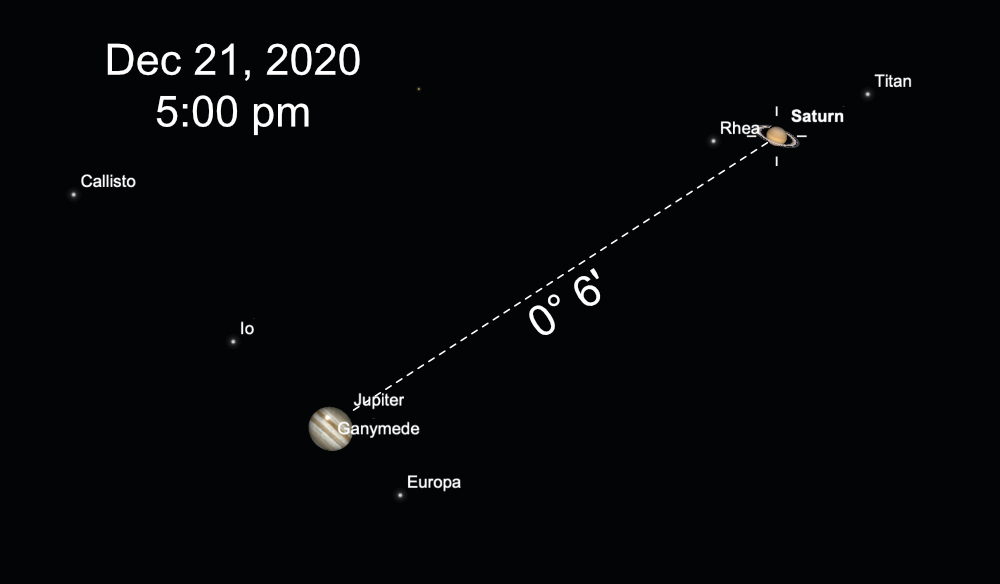| 2020: 'Christmas Star' Conjunction (2020-11-24) ⬅︎ |
 |
When Jupiter last passed Saturn, it was May 20, 2000. At their closest, they were a bit
over 1° (one-degree) apart in our sky. Since a full moon is 0.5° or 30' (thirty-minutes) in angular size,
Jupiter
and Saturn were about two-moons apart.
On December 21, 2020, Jupiter will once again pass Saturn but this time they will be just 6' (six-minutes) apart,
about 1/5 of the
width of a full moon. This will be so close that the two planets will appear as one bright star
when viewed naked-eye. The last time they were this close was the year 1623 -- nearly 400 years ago -- making
the 2020 conjunction a once-in-a-lifetime event.
When viewed through a binocular or telescope, you'll clearly see two separate worlds with multiple moons in orbit
as if they were all part of some fantastic double-planet system (see above) with over 160 moons combined.
What's actually going on? It may help by imagining two runners racing each other on an oval track. The faster
runner is in the inside lane while the slower runner is in the outside lane. They start their race side-by-side and the
faster runner quickly pulls ahead. In time, the faster runner catches up to and passes, or laps, the slower runner.
Jupiter and Saturn are like these two runners. They both orbit the sun in circular orbits. Jupiter, being closer to the
sun, is faster and orbits the sun every 11.86 years while Saturn takes 29.4 years. About every 20 years (actually
19.85 years),
Jupiter catches up to and passes Saturn.
All planets appear to follow a line or path known as the ecliptic that stretches from west to east across our
southern sky. So, when a faster planet passes a slower planet, they will both be close to this line and close to each
other. The actual distance apart during the conjunction can vary by a few degrees each time. Only rarely do they
appear to come together like Jupiter and Saturn will this year.
You might be familiar with a solar eclipse, an event that occurs when our moon passes in front of the sun
along this
line. It's no wonder that this line is called the ecliptic since all eclipses occur on it.
You don't have to wait for December 21st for the Great Conjunction of Jupiter and Saturn. Jupiter has been
approaching Saturn in our sky for many months. This last summer, they put on a great show appearing just 10°
apart. This is about the width of your fist held out at arm's
length.
When you can, look SW immediately after sunset for bright Jupiter/Saturn. Wait as the sky darkens. Once you spot
it, use a binocular or telescope to confirm your sighting and to view details.
Note that they will both be getting lower and lower in our sky as they approach conjunction so you'll need
a good, unobstructed view of the SW horizon (see above).
If you miss this one, there's always October 31, 2040 when Jupiter will next lap Saturn (yes, sarcasm intended).
But
they will be just over 1°
apart, like in the year 2000.
So let's hope for clear skies on the nights leading up to December 21, 2020!
For more info, see
Jupiter,
Saturn,
Ecliptic,
Angular Distance, and
Star Guide.
|
| |



